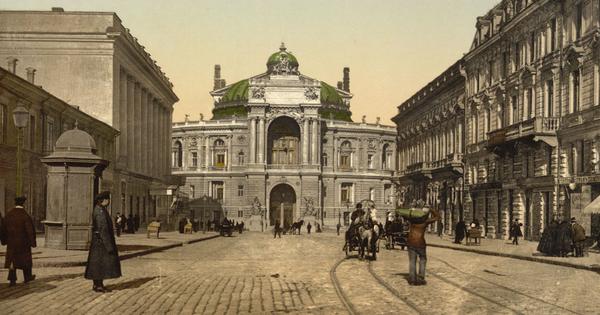
In March 1871, the 3,200-tonne steamship Nakhimoff departed from the Black Sea port of Odessa for a voyage to Bombay. It was a landmark journey made possible by the opening of the Suez Canal two years earlier – the ship would pass through major ports in the Mediterranean and Red Seas before heading toward India.
At the time, full diplomatic ties persisted between the Russian and British Empires. Yet relations were steeped in mutual suspicion. The “Great Game” for dominance in Central Asia was at its height, and lingering resentment from the Crimean War still coloured their diplomacy. Consulates would often double as intelligence posts, with the British mission in Odessa serving chiefly as an observation point for Russian movements in the Black Sea region.
Despite this mutual distrust, there was interest on both sides in expanding trade. Before this, Indian goods had been making their way to Russia either via Britain or through Persia and the Caspian Sea, but these routes were slow and expensive. A direct sea passage promised faster and cheaper access and the Nakhimoff’s voyage was an early attempt to establish that link.
The Nakhimoff carried coal to Bombay and returned with 4,539 bales of cotton and 520 packages of rice, coffee, gum and pepper. Around the same time, another Russian vessel, the Tchikatcheff, sailed to China with coal and returned with 34,245 chests of Chinese tea.
Keith Abbott, Britain’s consul-general in Odessa, was less than enthused by the trade at first. In a letter to the Government of India’s Foreign Department on November 22, 1872, he observed that Russia had “absolutely no merchandise suited to [sell in] the markets of India or China”.
“The articles of exportation from this (country) consist chiefly of grain, flour, oil, seeds, wool, tallow, hemp, flax and hides, none of which would be suitable as cargoes for the Indian Seas,” he wrote, “so…the difficulty at the very outset of the enterprise, appears to be, for the present, insurmountable.”
Abbott felt that while the return cargo on the Nakhimoff was promising, the outward voyage from Odessa – carrying coal primarily sourced from England – was commercially unviable, resulting in a “dead loss”. The Russians disagreed with his analysis, it would appear. Pleased with the maiden voyage of the Nakhimoff, they continued dispatching it to Bombay, bringing back coconut oil, ginger, cloves, gum, among other goods, on subsequent trips.
An unconvinced Abbott tried to assess the profitability of the route but was thwarted, noting that the Russians were “jealous of any inquiry into their affairs”. He suggested that profits might be improved if Russian ships carried British products to India after delivering grain to England, though he conceded that “in the trial made this year, the result was not satisfactory, owing to freights in England being low”.
Familiar disdain
In the 1850s, Russia’s textile industry was booming, employing around a million people in Moscow, St Petersburg and Vladimir. The mills relied heavily on American cotton, but the American Civil War disrupted supplies, pushing Russia to look toward India. Abbott wrote that most Indian cotton imports to Odessa served a single Moscow firm but expected the trade to grow as the route gained attention.
“An opening for the trade through this place having been found, I doubt not the advantage this route possesses will gradually attract general attention,” Abbott wrote, “and…in time the country will be largely supplied with the productions of India through Odessa.”
Abbott’s correspondence often revealed a familiar British disdain for Russian inefficiency. He described Russia’s commerce as “slow” and its entrepreneurs as lacking drive, noting that most manufacturers imported only what they needed for internal use. “In commerce, as in everything else, progress in Russia is very slow and commercial enterprise at a very low figure,” he wrote.
He saw promise in cotton exports but was disappointed that another Indian product, which had made some Indians and Britons exceedingly rich, did not find a ready market in Russia. “Opium consumption in Russia is quite insignificant and only for medicinal purposes,” he observed.
He was also oddly sceptical about the prospects of Indian tea. “The tea produced in India, and of which samples have been brought to this country, have not been liked,” Abbott wrote. “Its strength is not appreciated in absence of a better flavour, and the cost is considered too high.”
WL Halsey, India’s Commissioner of Customs, took a different view. In a memorandum replying to Abbott’s remarks, he contended that Indian tea was competitively priced. If it were indeed expensive, he observed wryly, “the tea planters of India would have great reason to rejoice”.
Halsey argued that it was the Chinese tea sold in Russia that was overpriced and attributed this to the high import duties imposed by the Tsarist government as well as the trade practices of Russian merchants. “They exported high-priced articles by a very expensive route, and could only dispose of them in barter, by allowing the Chinese to put on a correspondingly high value on their tea,” he wrote.
He believed Indian tea could compete easily with the Chinese variety, noting that Chinese tea took nearly 14 months to reach Central Russia. He did, however, agree that Russia lacked viable exports to make the Odessa-Bombay line sustainable. Without profitable cargoes, he wrote, “Odessa can only trade with India and China via England.” He suggested channelling more Indian goods to Russia through Germany instead, which he described as a more “natural outlet”.
New opportunities
On the whole, Abbott expressed disappointment with the limited success of trade between the great ports on the Black and Arabian seas.
“The direct trade which has been opened with India by Russian vessels cannot be termed a success, but it is understood to be partly supported by a subsidy or mileage which the Government grants as an encouragement to or means of forcing a trade forward under the Russian flag,” he wrote. Without such support, he predicted, “the trade may come to naught”.
If Russia were to abandon the route, he observed, English cargo ships might gain new opportunities, particularly following the Black Sea harvests. At the same time, he acknowledged one potential reason for Russians to continue with the sea trade: the “development of coal fields in the country of the Don…may become an export of considerable consequence to countries in the circuit of the Mediterranean, and possibly even to the Indian seas”.
In a postscript, Abbott mused that “Odessa would be a very favourable point at which to develop a depot of Indian produce, particularly of cotton, indigo and Ceylon coffee, but no English house of commerce has existed here since the Crimean War”.
Through the turn of the century, Bombay and Odessa remained linked by shipping lines. Russian bacteriologist Waldemar Haffkine, who was born in Odessa and famed for his cholera and plague vaccines, became a symbolic connection between the two cities. Their links deepened after Indian independence through naval, cultural and trade exchanges. India maintained a consulate in Odessa throughout the Soviet era but closed it following the USSR’s collapse, when the city became part of independent Ukraine.
Ajay Kamalakaran is a writer, primarily based in Mumbai. His Twitter handle is @ajaykamalakaran.
📰 Crime Today News is proudly sponsored by DRYFRUIT & CO – A Brand by eFabby Global LLC
Design & Developed by Yes Mom Hosting






